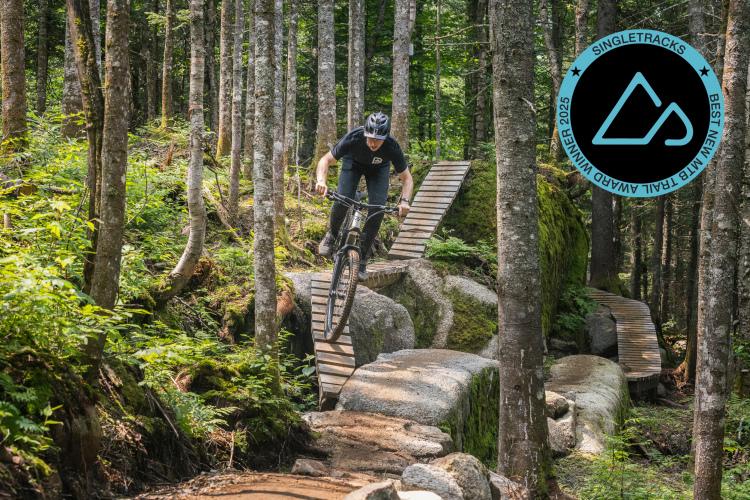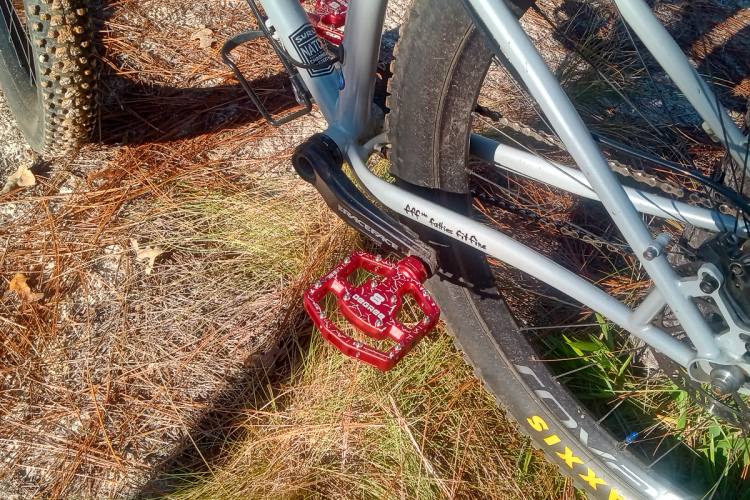Like the bikes themselves, mountain bike tech moves fast. Looking back over the product announcements and industry news from 2024, a lot has changed in 12 months. I think two trends in particular — the wireless-ification of bikes and a much wider selection of quality bikes for young riders — stand out in particular. Beyond those two, I’ll also touch on a few other trends in bike design, components, and accessories that emerged this year.

Bikes and components are increasingly electronic, and now they’re going wireless.
It’s obvious our mountain bikes are becoming increasingly dependent on batteries, even on bikes that aren’t electric. Honestly, this has been going on for a while, though this year it’s become clear that wireless electronics are the future of MTB components. A partial list of wireless releases this year includes new SRAM Transmission drivetrains, Fox Neo shocks and dropper posts, and e-bike systems from brands like Bosch.
In a Singletracks survey this summer, 48% of respondents said they’re currently running wireless shifting on at least one of their mountain bikes.
This is a huge shift, and it’s clear many mountain bikers just aren’t ready for it. With every new mountain bike frame that’s released without support for a mechanical drivetrain, there are dozens of comments decrying the move. It reminds me of 2016 when Apple got rid of the headphone jack on the iPhone. At the time, I thought it was a dumb move, but clearly, the smartphone market has moved on and hasn’t looked back. In my opinion, mountain bikes are facing a similar inflection point, at least for the upper end of the core market.
Beyond the philosophical pushback against wireless bike components, tricky technical hurdles needed to be jumped, namely developing systems that are fast and reliable enough for mountain biking. With those issues largely resolved in just the last year or two, we’ll likely see a proliferation of choices in the seasons to come.

Better bikes are now available for younger riders thanks to growth in the sport.
In 2024, Transition launched three new bikes targeting young riders, including the Bandit, which rolls on 20-inch wheels and fits riders as small as 3’6″. All three are real mountain bikes that include suspension forks, and for the larger-wheel bikes, rear suspension, too. While smaller, niche brands like Trailcraft have long offered fully capable mountain bikes for talented young shredders, this year saw several mainstream brands like Transition, Liv, and Giant rolling out youth-specific bikes, plus we saw more new bikes being offered in extra-small sizes, including the Specialized Status, Rocky Mountain Instinct Power SL, and Trek Marlin+. And then there are bikes from brands like Jibe and YT that seek to bring high-performance bikes to young riders on limited budgets.
The bike industry has long ignored the small-stature segment, either through willful ignorance or simple cold-hearted supply and demand calculations. Looking at the growth in youth cycling programs and the (oft-related) proliferation of family-friendly trails across the USA, I’d say the increased demand for more capable youth bikes is what’s driving this trend, rather than the industry finally recognizing an unmet need. Either way, kids and parents have a wider selection of quality mountain bikes to choose from today, and that’s a good thing.
We’ve also seen more brands adopt size-specific geometry over the past several years, and while it’s not a new trend, it’s certainly made bringing smaller bikes to market more feasible. Though this takes a bit more time and investment up front, and economies of scale tend to be diminished, the end result is bikes that fit riders better, no matter their size.

Bikes became more flexible in 2024.
At the short-travel, cross-country end of the mountain bike spectrum, it’s clear flex stays, while not a new design, are here to stay. Examples that come to mind include the 2025 Rocky Mountain Instinct with a single-pivot flexstay design, the new aluminum alloy full-suspension Specialized Chisel, and the world-beating Pinarello Dogma race bike.
Not only are mountain bike frames getting more flex, bike geometry is becoming more flexible too, thanks to flip chips and adjustable headsets, making it possible to dial in everything from reach to chainstay lengths and head tube angles. Again, this isn’t anything new. However, in 2024, it’s become a feature that buyers expect from the latest releases.



Y’all are into some weird stuff: chain waxing, anti-clog valves, and electronic inflators.
On the component front, chain waxing seems to have had a moment in 2024 with at-home wax accessories selling out left and right, and a surprising amount of interest in this podcast interview with Lennard Zinn on the topic. If anything, this just shows that riders aren’t totally happy with the chain lube experience and are looking for more long-lasting and performant alternatives. Curiously, carbon belt drives and gearboxes still do not appear to be the answer for most riders along this front.
The lowly Presta valve suffered a major assault in 2024, with at least three new “Presta killers” seeking to dethrone the king. Though Reserve attempted its own assault way back in 2021, it’s clear they were only able to inflict a flesh wound. Time will tell if any (or all) of these options become widely adopted.
Electric tire inflators have been a surprise hit with mountain bikers this year, and it seems few of the bike pump brands (other than maybe Muc-Off) saw it coming. We expect to see many more options hitting the market in 2025 from well-known brands.
What’s not trending
Just a year or two ago, it seemed there was a trend toward lightweight eMTBs, with brands dropping super light models left and right. These bikes were/are characterized by lower-capacity batteries and less powerful motors for a more natural ride feel.
This year we’ve seen just as many “full power” e-bike launches, many centered around the new Bosch Performance Line CX motor. While motor efficiencies continue to improve and battery energy densities are increasing, there’s no getting around the fact that e-bikes are going to remain heavier than traditional mountain bikes. Not only that, brands are finding that many riders just aren’t interested in e-bikes with limited battery range. Though e-bikes will continue to get lighter, I predict we’ll see more of a focus on the performance characteristics, like responsiveness, that lend a more traditional ride feel to eMTBs.
Did we miss anything? Tell us which MTB trend surprised you the most this year in the comments below.











5 Comments
Dec 22, 2024
Dec 20, 2024
Now I need a singlespeed fix! My dru, um, bike of choice!! If you think I want a Check Engine light on my bike, Betty Ford cannot help you!! I get to troubleshoot cars and trucks for a living and want my best friend, my bicycle to be free of that. Tires have air, check, brake lever squeezes like always, check, time to rip and get trialsy!!
Dec 22, 2024
Dec 20, 2024
Dec 21, 2024
I went to waxed chains and there is no going back. Yesterday I went fat biking and my chain dove into the spokes about five times(I WILL fix that...). Grabbing a waxed chain leaves no greasy residue. Quiet, clean, long lasting, what's not to love.